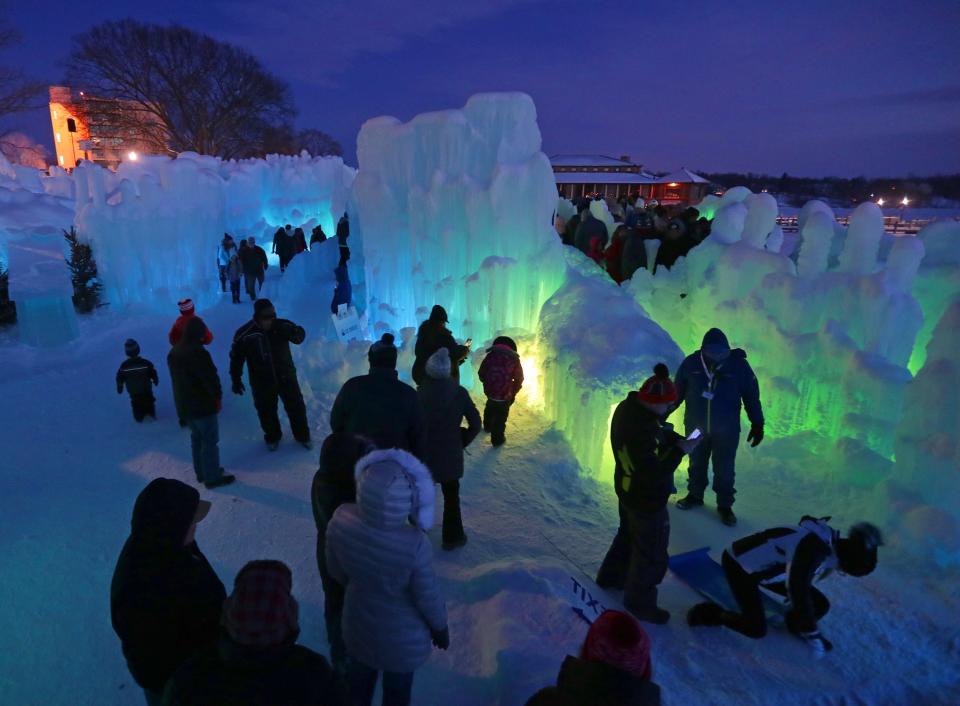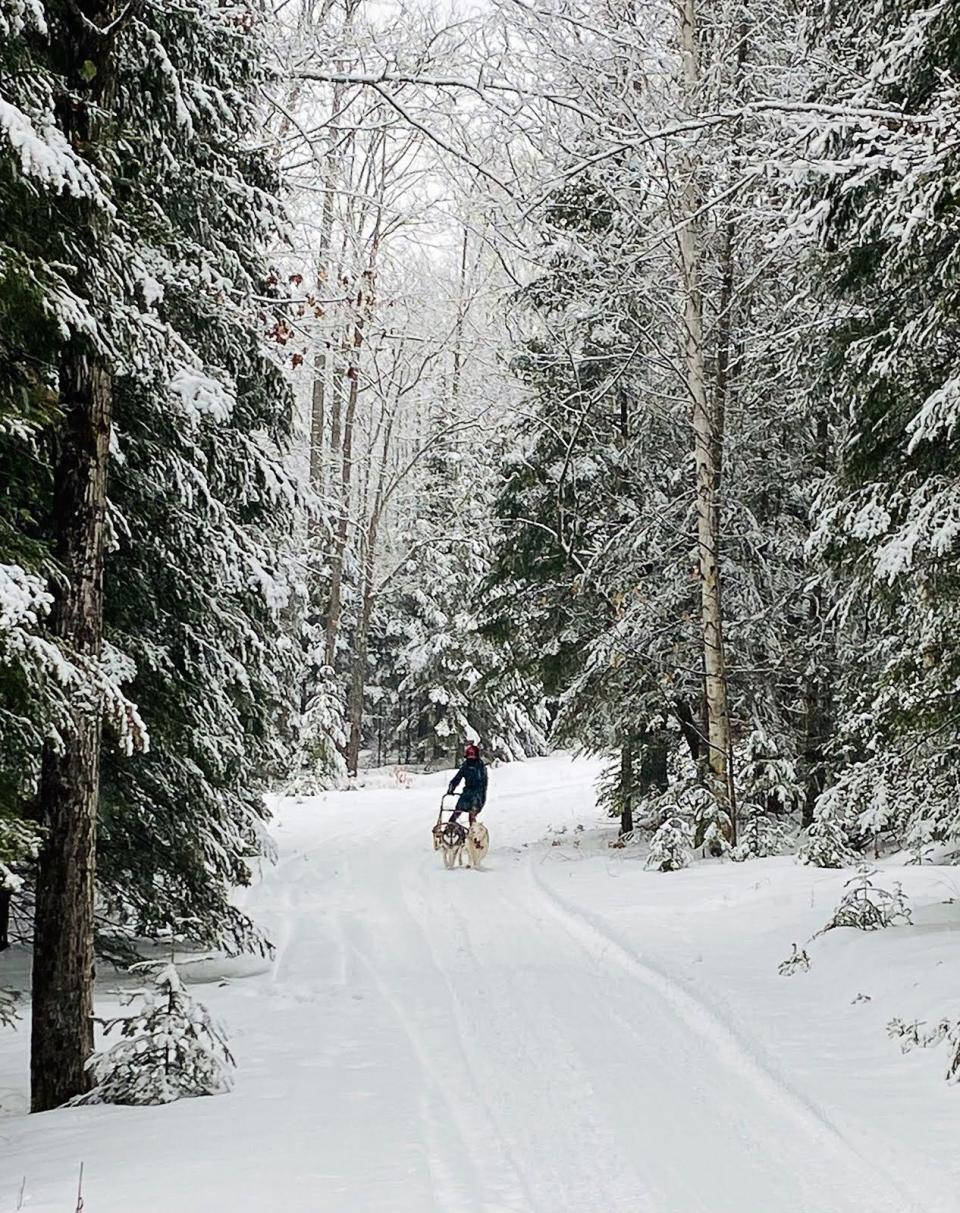Wisconsin winter bucket list: 12 things you have to do
Yes, a Wisconsin winter means months of cold and snow.
But also, a Wisconsin winter means months of cold and snow — months to do things in that cold and snow that you can’t do any other time of year.
When else can you cross-country ski on a Great Lake, with giant bonfires and ice luminaries lighting the way?
When else can you drive on a four-lane highway across a frozen lake?
When else can you watch people race bar stools down a snowy hill — your uncle's backyard notwithstanding?
Winter is inevitable in Wisconsin, so we might as well make the most of it. Here are 12 ways to do that — think of it as a winter bucket list, of sorts.
Snowshoe or ski by candlelight
Candlelight events abound in Wisconsin in the winter, and Book Across the Bay in far northern Wisconsin is the granddaddy of them. The 10-kilometer ski and snowshoe race takes place in February on frozen Lake Superior, with ice luminaries and giant bonfires lighting the way. Some do it at a race clip, but others take their time on the route across Chequamegon Bay from Ashland to the opposite shore south of Washburn, then back again.
No matter your pace, though, trekking more than 6 miles on a frozen lake at night is not easy. If you want to capture some of that magic without going so big, try a candlelight ski, snowshoe or hike event at a park or nature preserve — there are more than 50 across the state this winter.
For more on Book Across the Bay and to register, see batb.org.
Bike on a frozen lake
If you’ve walked, snowshoed and skied on a frozen lake, it’s time for a frozen bike ride.
During Bike Across Bago, hardy cyclists ride 18 miles on frozen Lake Winnebago. The free ride ($10 donation encouraged), scheduled for the first Saturday in February, starts and ends at the Paynes Point Hook & Spear Fishing Club south of Neenah, with a few rest stops along the way. The ride is tough — you’re biking on ice, after all — and it’s best to have studded tires. See the event’s Facebook page for more information.
Up north on Lake Superior, bike 10 or 20 kilometers on frozen Lake Superior in February during Bike Across the Bay, following part of the same course as Book Across the Bay, which takes place the day before. The fat-bike race requires at least 3.5-inch tires, and studs are recommended. Find more information at northcoastcycling.com.
Drive on a frozen lake
Are you really a Wisconsinite if you’ve never driven on a frozen lake? No ice is ever 100% safe to drive on, but at least on frozen Lake Winnebago there's someone checking it regularly. Once the ice is thick enough, local ice fishing clubs plow and maintain a 75-mile network of roads, including placing bridges across cracks. Anyone can use the roads — including commuters traveling between Oshkosh and Quinney, on opposite sides of the 10-mile-wide lake — and some fishing clubs collect voluntary membership fees to help pay for the plows, gas and bridges.
Farther north on Lake Superior, when conditions allow, an evergreen-tree-lined ice road opens between Bayfield and La Pointe on Madeline Island. Sometimes the road is only open to local traffic — i.e. people who live on the island. If it is open to the general public, you can use it to access Big Bay State Park. For current conditions, call (715) 747-5400.
Visit an ice castle

Like something out of “Frozen,” the Ice Castles first appeared in the Dells in 2017, then in Lake Geneva beginning in 2019. The Utah-based company brought them back to Lake Geneva this year, now at Geneva National Resort & Club. The castles are built with hundreds of thousands of icicles that are sprayed with water, creating ice walls where builders then carve out passageways, slides and thrones. Colorful LED lights add to the spectacle at night.
The castles are weather-dependent but usually open in mid- to late-January. Tickets typically go on sale in November and usually sell out in advance. See icecastles.com.
Long before the Ice Castles took over social media, however, Eagle River was building its own ice castle out of giant blocks of ice harvested from Silver Lake. Volunteers with the local fire department build the 20-foot structure when conditions allow, usually in late December or early January when ice on the lake is at least 14 inches thick. You can’t walk inside this castle, but you can snap photos outside — for free, or a donation to the fire department if you choose.
Visit an ice cave
Nature creates its own ice castles around Wisconsin. The most famous are in the Apostle Islands, where water freezes in icy formations along the red-brown sandstone cliffs and caves of the national lakeshore. The ice caves are even more special because you can’t always access them — Lake Superior must freeze enough to support people walking about one mile from Meyers Beach on the northwest side of the Bayfield peninsula to the mainland caves. That requires long spells of cold weather without winds that break up the ice. In the last 10 years the caves have been accessible just twice: in 2014 and 2015. If the National Park Service does deem them accessible, it most likely won’t be until February. Call (715) 779-3398 (ext. 3) or see nps.gov/apis for up-to-date conditions, and do not venture onto the ice unless the NPS gives the OK.
If the mainland caves don’t open, there are caves on the east side of the peninsula that are accessible most winters, since that side is more sheltered from rough winds. Those caves are on land owned by the Red Cliff Band of Lake Superior Chippewa and are only accessible on a tour with Rustic Makwa Den, which is run by tribal members. Tours are usually held at 10 a.m. and 2 p.m. daily, January through March; see apostleislandsrusticmakwaden.com or call (715) 209-3319.
For similar ice formations around Wisconsin, check out the Kickapoo Valley Reserve near La Farge, Cave Point County Park in Door County, and Wequiock Falls County Park and Fonferek's Glen County Park outside Green Bay.
More: 5 places other than the ice caves to see ice formations in Wisconsin
Go mushing

Mushing, or dogsledding, is part thrill ride and part scenic ride through Wisconsin's beautiful winter landscapes. A few outfitters in northern Wisconsin offer a chance to drive your own team or just ride along in the sled, including Wolfsong Adventures in Mushing out of Bayfield. The outfitter offers morning, afternoon and sunset tours that include the chance to harness and feed the dogs. Call (715) 779-5561 or see wolfsongadventures.com.
Top of the Hill Huskies, near the Wisconsin-Michigan border in Phelps, offers two-hour mushing adventures through the Northwoods. Call (715) 891-2704 or see topofthehillhuskies.com.
Ski Wisconsin’s biggest vertical drop
Wisconsin doesn’t have the vertical of mountainous states, but Rib Mountain’s Granite Peak is the state’s biggest, with a 700-foot drop. The ski hill outside Wausau has 68 runs — the longest of which is almost a mile — and four terrain parks serviced by seven lifts, including three high-speed lifts. The ski area also offers rentals and lessons for kids and beginners.
Visit at the end of the season for the annual Spring Fling, when costumed skiers and snowboarders try to skim over a small pool of water on the ski hill.
For lift tickets, hours and more information, call (715) 845-2846 or see skigranitepeak.com.
Ride a toboggan
For a different kind of drop, try the toboggan run at Waukesha’s Lowell Park. Bring your own toboggan or rent one for the 350-foot trip down the lighted chute. A day pass is $10 (cash only), which includes a rental (driver license or $60 deposit required); advanced registration is required. When conditions allow (i.e. there is snow), the run is open 1 to 4 p.m. Saturdays.
The chute is free to ride on the weekends during the annual Waukesha JanBoree in January, but registration is still required. Other activities during the festival include ice sculpting demos, a balloon glow and fireworks.
Race a bar stool
Wisconsin winters inspire creative solutions to fend off boredom, and Drummond’s Bar Stool Races top the list. Competitors trick out bar stools with skis, handles and more, then ride them down a snowy hill behind the Black Bear Inn. The annual event, scheduled for the third Saturday in February, is a fundraiser for the local snowmobile club, the Sno-Jacks, and includes food, drinks, raffles and prizes. Registration is $30 in advance, or you can watch the spectacle for free. See drummondwi.com.
Sip a beer outside at Mitten Fest
The city of festivals doesn’t sleep in winter. Just as cabin fever is raging in February, Milwaukee bar Burnhearts hosts Mitten Fest, a block party-beer festival hybrid with live music, a craft fair, food trucks and a wide selection of cocktails and beer for sale, including rare offerings from breweries like Central Waters and Bell’s. The free festival does some good, too, collecting food, winter clothing and money for the Hunger Task Force.
Watch champion snow sculptors
Teams of artists turn giant blocks of snow into masterpieces in Lake Geneva during the U.S. National Snow Sculpting Championship, usually the last week in January or the first week in February. Watch them work along the lakefront downtown during the week and vote for your favorite before the final judging. See visitlakegeneva.com/winterfest.
Take a polar plunge
There are few good reasons to submerge yourself in ice-cold water. The Special Olympics is one. The nonprofit hosts a handful of polar plunges around the state in February and March, with plungers raising a minimum of $75 each for the organization. The events have safety precautions in place — including first responders on-site — plus heated changing tents for warming up after. See polarplungewi.org.
RELATED: 50 things to do with your kids this winter around Milwaukee, from kites on ice to Disney on Ice
Contact Chelsey Lewis at clewis@journalsentinel.com. Follow her on Twitter at @chelseylew and @TravelMJS and Facebook at Journal Sentinel Travel.
Our subscribers make this reporting possible. Please consider supporting local journalism by subscribing to the Journal Sentinel at jsonline.com/deal.
DOWNLOAD THE APP: Get the latest news, sports and more
This article originally appeared on Milwaukee Journal Sentinel: Wisconsin winter bucket list: 12 things you have to do
